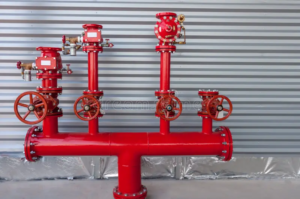
Navigating the World of Alarm Valve
Alarm valve serves a crucial role in many security systems, often acting as the first line of defense in emergencies.

The Fundamental Types of Alarm Valves
1. Wet Alarm Valves
A staple in most fire sprinkler systems, the wet alarm valves are designed for systems that have water in the pipes constantly. When a sprinkler activates, water flows, triggering the alarm valves.
2. Dry Alarm Valves
Suitable for places where pipes could freeze, dry alarm valves operate in systems that keep air in the pipes until a sprinkler is activated. Water then replaces the air, setting off the alarm valves.
3. Delayed Alarm Valves
This type of alarm valves offers a delay before the alarm activates. It’s beneficial in scenarios where there might be brief, harmless surges in the water supply.
4. Deluge Alarm Valve
Found in areas needing high-speed sprinkler activation, like chemical storage, this valve releases water to all sprinklers simultaneously when a separate fire detection system is triggered.
5. Pre-action Alarm Valve
Used in areas where accidental activation can be costly, like data centers, this valve requires a two-step process: a fire detection system activation followed by a sprinkler activation.
Key Features of Each Alarm Valve Type

Wet and Dry Distinctions
The choice between wet and dry often hinges on the location’s temperature. Cold areas favor the dry variant.
Delay Benefits
Delayed alarm valves reduce false alarms, especially in places with fluctuating water pressure.
Speed with Deluge
Deluge alarm valves guarantee rapid response in high-risk areas.
Accuracy with Pre-action
With a two-step activation, the pre-action alarm valve minimizes false activations, crucial in sensitive areas.
Applications in Modern Systems
Industrial Settings
Here, deluge alarm valves are popular, ensuring rapid responses during chemical fires.
Residential Complexes
Wet alarm valves dominate, given the controlled temperature and need for instant alerts.
Data Centers
The precision of pre-action alarm valves is unmatched, making them the top choice for such crucial infrastructures.
Maintenance and Care
Regular Inspection
Every alarm valve, regardless of its type, requires periodic checks to ensure it’s working optimally.
Replacement Needs
Over time, wear and tear can affect an alarm valve’s efficacy. Knowing when to replace is essential.
The Importance of Choice
Selecting the right alarm valve type can make a significant difference in safety efficacy. Each type is tailored for specific scenarios, ensuring optimal performance when chosen wisely.
Conclusion
Alarm valves, while often overlooked, are integral components of many security systems. Each type, from wet to pre-action, serves a distinct purpose, catering to different environments and requirements. By understanding these types, one can make informed decisions, ensuring maximum safety and efficiency in various settings. As the world evolves, the importance of such silent protectors, like the alarm valve, becomes even more pronounced, standing guard and ensuring safety in countless scenarios.


